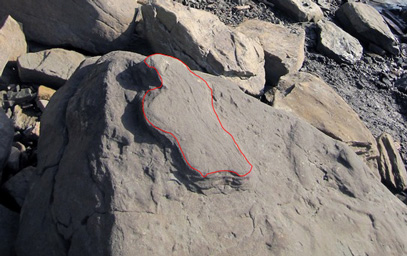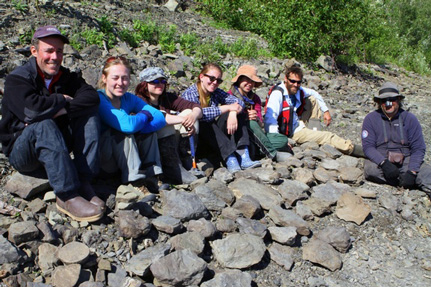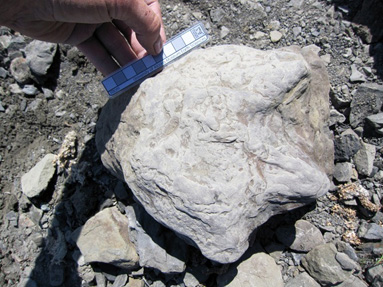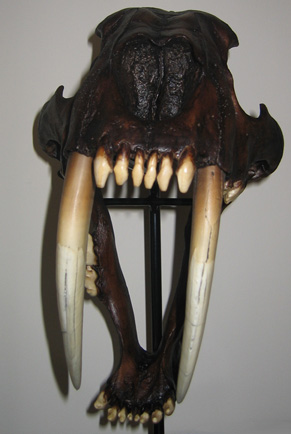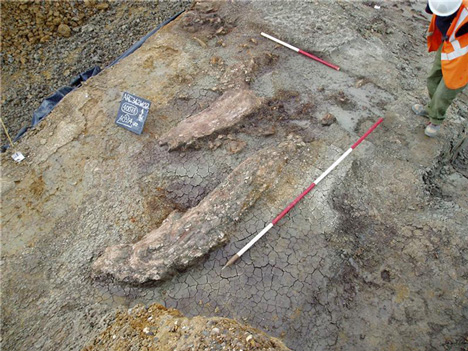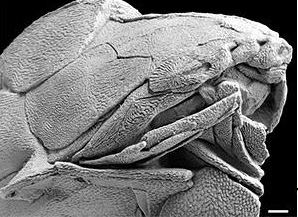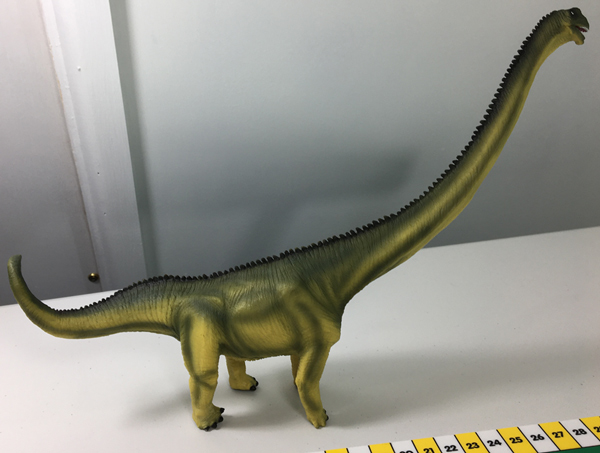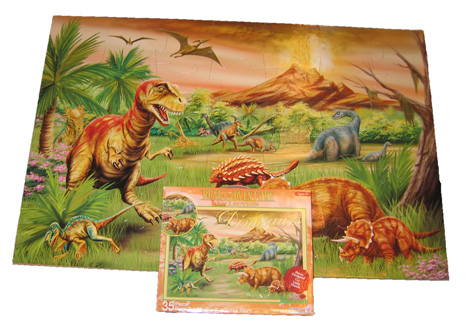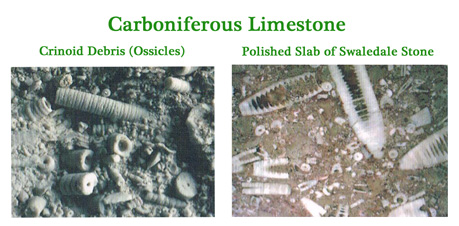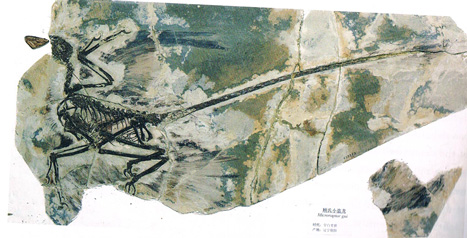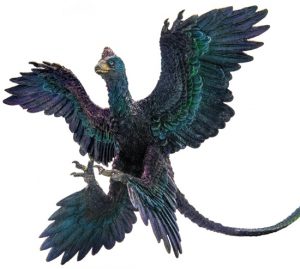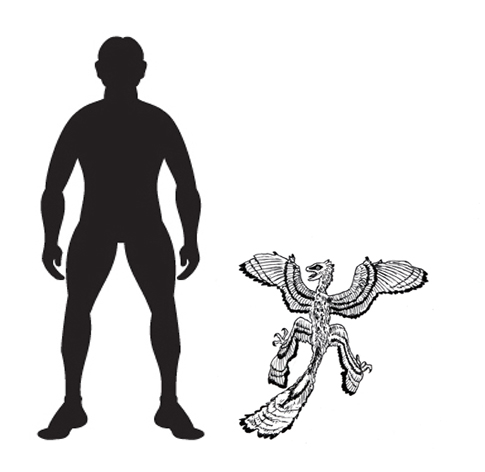Thousands of Dinosaur Tracks Discovered along the Banks of Alaska’s Yukon River
Evidence of an Extinct Ecosystem Revealed
A team of researchers from the University of Alaska Museum of the North have found a number of major new sites which show evidence of Late Cretaceous dinosaur fossils, not too far from the Arctic Circle. The research team explored the banks and rocky beaches of the Yukon and Tanana rivers and the expedition returned with over 900 kilogrammes of dinosaur trace fossil specimens. The fossils represent extensive dinosaur tracks and prints.
Dinosaur Tracks
Commentators have stated that the University of Alaska Museum of the North researchers have found major new sites for dinosaur fossils in Alaska.
Earth Sciences Curator Pat Druckenmiller, a member of the expedition team commented:
“There aren’t many places left in the world where palaeontologists can just go out and find thousands of dinosaur footprints”.
In the high summer (July) with the long days of daylight, the research team set off at the start of a 800 kilometre journey, one that would take them down the Tanana and Yukon rivers and also back in time to the Cretaceous a time when, according to the trace fossils, a large number of different dinosaur species roamed these northern latitudes.
Operations Manager at the Museum, Kevin May stated:
“Based on what we know about the geology along the Yukon River, the rocks exposed downriver from Ruby [a small town 400 kilometres west of Fairbanks] suggested they might be a good place to find dinosaurs”.
Ornithopod and Theropod Tracks
Footprints of both plant-eating dinosaurs (ornithopods) and meat-eating dinosaurs (theropods) were discovered indicating that this part of the Late Cretaceous world supported a rich and diverse ecosystem. Many different types of prehistoric animal footprint have been recovered from the nearby Denali Park (Lower Cantwell Formation), including those of a giant prehistoric bird that may have stood over 1.5 metres tall.
In fact, the nearby Denali Park is famous for its extensive bird fossil trackways, it seems that birds were also abundant and shared this Late Cretaceous habitat with the dinosaurs. Intriguingly, the newly discovered dinosaur footprints from the Yukon area are probably 25-30 million years older than the Denali fossils, still Late Cretaceous but indicating a rich and diverse ecosystem flourishing in this part of the world for many millions of years.
Preserved Dinosaur Footprints Found Along the Shore
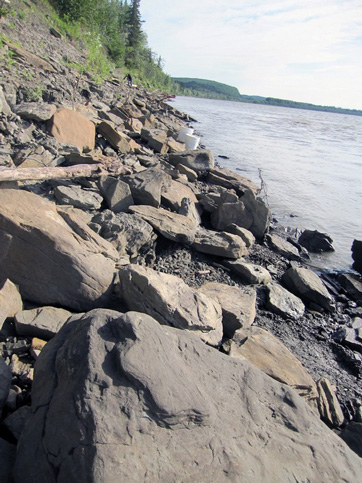
Picture credit: Pat Druckenmiller
The picture above shows the typical shoreline landscape with large boulders littering the shoreline that have been eroded out of the surrounding strata. The boulder in the foreground shows a positive footprint fossil.
Yukon River Dinosaur Footprints
A Positive Dinosaur Footprint – Ceratopsian Hind Foot?
Picture credit: Pat Druckenmiller with highlighting by Everything Dinosaur
The picture above shows a close up of the dinosaur footprint, although team members at Everything Dinosaur have only this photograph to study and there is no defined scale, it has been suggested that this trace fossil may have been made by the foot of a ceratopsian (horned dinosaur).
Natural Casts
Pat Druckenmiller explained that one of the reasons the Yukon River dinosaur tracks may have gone undiscovered for so long is due to their method of preservation, they are “natural casts” formed when sand filled in the actual footprint after the dinosaur stepped in soft mud. The footprints are not “sunken impressions”, as we refer to such tracks at Everything Dinosaur, rather, they are “raised positive impressions”, that actually stick out and stand proud of the surrounding matrix. A spokesperson for the Alaskan based team stated that the prints “stick out from the rock and sometimes look like blobs with toes.”
The fossil finds are significant as they hint at an extensive dinosaur rich ecosystem that predates those fossils found from the Lower Cantwell Formation of Denali. The University of Alaska Museum of the North are keen to work with local native communities to help co-ordinate future expeditions to the area, perhaps looking for body fossils of dinosaurs so that new genera of Dinosauria may be identified. The dedicated dinosaur footprint spotters included, Jørn Hurum, from the University of Oslo Natural History Museum, UAMN Earth Sciences Collection Manager Julie Rousseau, and University of Alaska (Fairbanks) students Meghan Shay, Katherine Anderson, and Meg O’Connor.
Some of the Expedition Members with their Finds
Picture credit: Kevin May
A Rich and Diverse Dinosaur Fauna
The Head of Production at the Museum Roger Topp, has produced a film of the team’s exploits and the University of Alaska Museum of the North is planning to exhibit their finds in the summer of 2015.
Commenting on the fossil footprint discoveries, a spokesperson from Everything Dinosaur said:
“From the preliminary studies that have been made, these fossilised footprints indicate a rich Dinosauria fauna, with herbivorous ceratopsians and duck-billed dinosaurs dominating the mega fauna. These animals may have migrated to high latitudes to take advantage of food resources during the long periods of prolonged daylight. Predators such as tyrannosaurs may well have followed these herds north and south, picking off the sick and the old.”
A Close Up of an Ornithopod Footprint
Picture credit: Pat Druckenmiller


